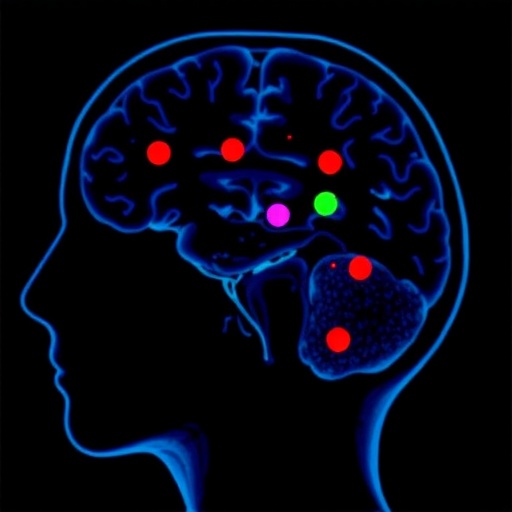In the relentless battle against glioblastoma (GBM), one of the deadliest and most aggressive brain tumors, researchers continue to seek novel biomarkers that can offer clinicians an edge in predicting patient outcomes and monitoring disease recurrence. A recent breakthrough study published in BMC Cancer introduces the dynamic analysis of the neutrophil-to-lymphocyte ratio (NLR) as a promising prognostic tool, shedding light on the complex immunological interplay influencing glioblastoma progression and survival.
Glioblastoma remains a formidable challenge due to its rapid growth, resistance to therapies, and inevitable recurrence, which collectively contribute to dismally low survival rates. Traditional prognostic factors such as age, performance status, and extent of surgical resection only partially explain patient variability. Thus, there is an acute demand for reliable, easily measurable biomarkers capable of refining prognosis and guiding post-treatment surveillance strategies.
The NLR, a simple blood-based inflammation marker derived by dividing the number of circulating neutrophils by lymphocytes, has garnered attention across multiple cancer types as a potential prognostic indicator. Elevated NLR values often reflect a systemic inflammatory state, which is implicated in tumor progression. However, its dynamic changes throughout treatment and their relevance in glioblastoma prognosis had not been fully elucidated—until now.
This pioneering study examined a cohort of 69 newly diagnosed GBM patients, all of whom underwent the standard aggressive treatment regimen known as the Stupp protocol, which combines surgical resection, radiotherapy, and chemotherapy with temozolomide. Researchers meticulously measured NLR at carefully selected time points: preoperative, post-concurrent chemoradiotherapy (post-CCRT), and post-Stupp protocol completion, focusing on how shifts in NLR—quantified as dynamic NLR (dNLR)—related to overall survival (OS) and progression-free survival (PFS).
Analysis revealed striking associations between the post-Stupp NLR and patient outcomes. Specifically, patients exhibiting a post-Stupp NLR of 5 or higher, or a dynamic NLR increase—defined as dNLR greater than or equal to 1.3—faced significantly poorer overall survival. These findings persisted even when adjusted for crucial clinical confounders such as age at diagnosis, preoperative Karnofsky Performance Score (KPS), and extent of tumor resection, underscoring the NLR’s independent prognostic value.
Notably, multivariate Cox regression models unveiled that older age (≥70 years), a lower preoperative functional status (KPS ≥60), and the aforementioned thresholds of post-Stupp NLR and dNLR were all significantly linked to higher mortality risks. The dynamic nature of NLR, capturing changes induced by treatment and tumor-host interactions, may offer a more nuanced prognostic signal than static pre-treatment values alone.
Beyond overall survival, the study also highlighted the role of NLR dynamics in progression-free survival. Post-Stupp dNLR elevations correlated with shorter intervals before tumor recurrence, suggesting that escalating systemic inflammation or immunosuppression might prelude radiographic or clinical relapse of GBM. This opens the intriguing possibility that serial monitoring of NLR could serve as a minimally invasive surveillance biomarker, potentially heralding recurrence prior to conventional imaging detection.
The biological rationale behind NLR’s prognostic power lies in the intricate tumor-immune crosstalk characterizing glioblastoma. Neutrophils contribute to tumor growth and invasion through secretion of proteases, cytokines, and pro-angiogenic factors, while lymphocytes, particularly cytotoxic T cells, mediate antitumor immunity. Thus, a high NLR denotes a shift towards a pro-tumoral, immunosuppressive environment—a finding corroborated across diverse malignancies.
Moreover, the dynamic changes in NLR reflecting treatment response or failure emphasize the evolving nature of the tumor microenvironment. As chemoradiotherapy modulates immune profiles, patients whose NLR increases might harbor residual aggressive disease or developing resistance, thereby experiencing accelerated progression.
These insights align with a growing paradigm recognizing systemic inflammation as a modifiable factor in cancer management and highlight the importance of integrating immunological biomarkers into personalized treatment planning. If validated in larger cohorts, NLR dynamics could enrich clinical decision-making, guiding intensified therapies or enrollment into immunomodulatory clinical trials for those identified at high risk.
The study is not without limitations. Its relatively modest sample size and single-center design necessitate external validation before widespread clinical adoption. Additionally, the optimal timing and frequency of NLR measurements to maximize prognostic accuracy remain to be defined. The influence of confounding factors such as infections or corticosteroid use, which can affect white blood cell counts, also warrants closer scrutiny.
Nonetheless, this research exemplifies the power of accessible, cost-effective biomarkers to transform neuro-oncology practice. Blood tests like NLR are routinely performed, and leveraging their dynamics could provide clinicians with real-time insights into disease trajectory, complementing imaging and clinical evaluation.
In conclusion, the identification of post-Stupp NLR and dynamic NLR as robust prognostic markers in glioblastoma marks an exciting advancement in the quest to personalize care for patients afflicted with this devastating malignancy. These findings set the stage for future prospective studies and underscore the potential of immunological biomarkers in the ongoing endeavor to surveil glioblastoma recurrence and improve patient survival.
As the scientific community continues to unravel the immunobiology of glioblastoma, integrating dynamic biomarkers such as NLR into routine clinical workflows may soon enhance the precision of prognosis and treatment adjustments. Such strides bring hope that the grim outlook of glioblastoma can be gradually mitigated through informed, data-driven clinical interventions.
Subject of Research: Glioblastoma prognosis and recurrence monitoring using neutrophil-to-lymphocyte ratio dynamics.
Article Title: Neutrophil-to-lymphocyte ratio dynamics: prognostic value and potential for surveilling glioblastoma recurrence.
Article References:
Chung, MW., Tzeng, CC., Huang, YC. et al. Neutrophil-to-lymphocyte ratio dynamics: prognostic value and potential for surveilling glioblastoma recurrence. BMC Cancer 25, 709 (2025). https://doi.org/10.1186/s12885-025-14118-8
Image Credits: Scienmag.com




